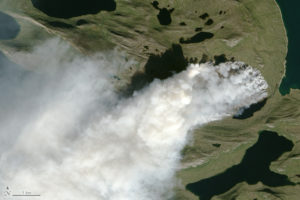Research Overview
Anthropogenic warming is amplified in the Arctic compared to other regions of the globe. Enhanced warming in this region may result in dramatic changes to tundra disturbance regimes, such as wildfire and thermoerosion, which may in turn facilitate carbon loss from permafrost soils as well as impact nutrient cycling and aquatic productivity. My research explores these linkages via geochemical and biological information preserved in lake sediments. I use a variety of proxy indicators to reconstruct fire, climate, and the thermal degradation of landscapes during the Late Quaternary, including analyses of macroscopic charcoal, chironomid headcapsules, and diatoms. I also use techniques such as loss-on-ignition, magnetic susceptibility, biogenic silica, C:N, C and N isotopes, carbonate isotopes, strontium isotopes, X-ray diffraction, and X-ray fluorescence. This research is crucial to understanding how tundra and boreal ecosystems will respond to ongoing climate change.
Active Research Projects
PROJECT #1: Navigating Disturbance Regimes in the New Arctic (National Science Foundation, Environmental Engineering Program – Grant #NSF-1927772)
This is a collaborative project with Dr. Mark Lara at the University of Illinois. Mark and I will use a combination of historical satellite imagery, chronosequence surveys of soils, and paleoecological reconstructions from lake sediments to investigate the relationships between fire, climate, permafrost erosion, and vegetation change on annual to centennial timescales. We will use these historical archives to assess disturbance-climate-vegetation feedbacks in Arctic tundra regions of Alaska. This project as important implications for the vulnerability of Arctic communities and infrastructure to projected climate change.

Some specific questions we aim to tackle in this project include:
- What are the underlying controls on decadal- and centennial-scale variability of permafrost degradation and tall shrub expansion?
- How has/will ecosystem structure and function evolve following disturbance?
- What are the relative roles of climate, wildfire, and permafrost degradation on shrub expansion and vice-versa?
- What are the decadal- and centennial-scale responses/feedbacks between interacting climate and disturbance regimes and how do they impact projected landscape evolution?
- Will interacting disturbance regimes mitigate/magnify biophysical and biogeochemical responses/feedbacks to global climate change?
- Where/when will permafrost degrade, and northern communities and infrastructure be most vulnerable to change?
- How vulnerable/resilient are northern Arctic villages to future climate- and disturbance-driven landscape evolution?
PROJECT #2: Fire history of SW Greenland: Characterizing long term climate-fire relationships using lake sediments (National Geographic Society – Grant #NGS-393R-18)
The goal of this project is to characterize long term climate-fire relationships in southwestern Greenland by analyzing charcoal particles deposited in lake sediments. These records provide context for recent fires that occurred in southwest Greenland in the summer of 2017. We retrieved lake sediment cores from these burn areas in the summer of 2018. We have already started gathering data on the geochemical composition of the sediments to relate to landscape development over the Holocene, analyzing sediments to identify charcoal deposition from recent and (if any) past fires, and picking insect remains for isotopic analyses and climate reconstructions.

Currently (summer 2019), Leo Veliz, an undergraduate student from the University of Buffalo, is subsampling and preparing sediments for charcoal analyses. Briana Edgerton, a new MS student in my lab, will dive into her thesis project, which will focus on untangling the climate history of these sites. Look for updates soon!